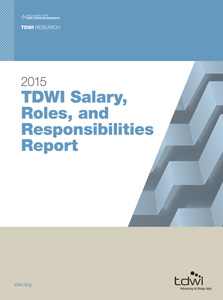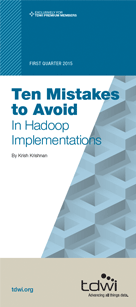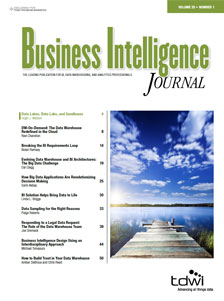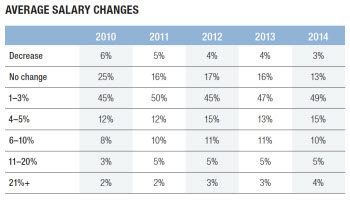 View online: tdwi.org/flashpoint
View online: tdwi.org/flashpoint





April 2, 2015
ANNOUNCEMENTS
NEW TDWI Checklist Report
Bringing Modern Data-Driven Applications to the Enterprise
NEW TDWI E-Book
Master Data Management Means Business with Data-Driven Applications
CONTENTS

TDWI Salary Survey: Average Salaries Rise 4.3% in 2014 for BI Professionals

How to Build Trust in Your Data Warehouse

TDWI Salary Report: Salary Trends

Mistake: Failure to Prevent Transformation Overload

See what's
current in TDWI Education, Events, Webinars,
and Marketplace

TDWI Salary Survey: Average Salaries Rise 4.3% in 2014 for BI Professionals
Mark Hammond
TDWI Contributing Analyst
Employees found 2014 was a good year for salaries in the BI industry, with the highest increases in five years for both full-time and contract BI professionals, according to TDWI’s annual salary report.
Average wages rose 3.4 percent in 2014 to a new high of $109,933 for full-time BI professionals in the U.S. and Canada, who comprise 94 percent of the 1,057 individuals polled for the 2015 TDWI Salary, Roles, and Responsibilities Report.
Meanwhile, average salaries leapt 12.3 percent for freelance BI contractors (6 percent of the respondent pool) to $132,879. Across both full-time and freelance constituencies, averages salaries increased 4.3 percent to $111,388, while the median wage was up 2.9 percent to $107,000.
Offsetting a slight decline in salaries in 2013, these gains go hand in hand with fairly strong bonuses widely distributed among BI professionals. Nearly two-thirds (64 percent) of respondents received a bonus in 2014, averaging $14,624, up slightly from the previous year.
Available exclusively to TDWI Premium Members, the 2015 TDWI Salary, Roles, and Responsibilities Report gives employees and managers insights into compensation trends as well as metrics such as job satisfaction, average BI team sizes, BI maturity, and top primary and secondary roles. The report examines salary and bonus data by a variety of dimensions, including:
IT certifications. Achieving certification in BI or other IT disciplines is a proven way to increase earning power. In 2014, BI professionals with at least one certification averaged $118,532 in salary compared to $105,230 for those with no certifications. Of the various certifications, BI professionals with TDWI’s Certified Business Intelligence Professional (CBIP) status fared the best in 2014, with an average salary of $125,905. Of CBIPs, 69 percent also pocketed a bonus, averaging $19,626.
Gender. Men continue to out-earn women in BI, with a gap of $12,581 in average salaries for 2014 ($102,434 vs. $115,015). Fewer women than men receive bonuses (58 percent vs. 66 percent), and the bonuses they do receive are substantially less than what men receive ($12,679 vs. $15,089). The BI gender gap has been documented for many years in this survey and shows little sign of diminishing.
BI maturity. Organizations with “advanced” BI environments pay the best salaries, averaging $117,693 in 2014—more than $17,000 greater than the $100,527 paid to those in “beginner” environments. Higher salaries in advanced environments have traditionally been the norm in this survey series, illustrating that investment in BI talent pays off with effective implementations.
Years at current organization. Changing jobs can be lucrative for BI professionals. In 2014, newly hired practitioners with a year or less at their current employer averaged $112,740 in salaries, well above the $100,342 paid to those with 11 to 20 years at the same organization.
Organizational size. Larger organizations tend to pay the highest salaries. Average wages of $123,694 for BI professionals at organizations with $50 billion or more in annual revenue are notably higher than the $107,546 paid by organizations with revenue between $100 million and $500 million.
Primary roles. As in past years, BI directors commanded the highest salaries among our respondents, at $140,939. Seventy-one percent also received a bonus, averaging $21,866, putting their total compensation at $162,805. At the low end, data analysts and modelers averaged $88,147 in salaries.
Get more insights with the full 2015 TDWI Salary, Roles, and Responsibilities Report, available to TDWI Premium Members.
Mark Hammond is a veteran contributor to TDWI, including a number of research reports, the Business Intelligence Journal, and TDWI FlashPoint.

How to Build Trust in Your Data Warehouse
Amber DeBroux and Chris Reed
The right mix of automated information controls, partnership, and execution are essential ingredients to supporting a successful and trusted data warehouse.
The introduction of big data has brought about new data challenges and raised the value of its contents. In addition, big data demands an adjusted and robust analytics platform. Now, more than ever, it is critical that you consider the appropriate methodology for ensuring data integrity to provide end users with sound data for critical decision making.
A data integrity solution should have flexible control logic capabilities and be able to perform numerous validation types. This article offers best practices for establishing such a solution and increasing its overall efficiency.
Learn more: Read this article by downloading the Business Intelligence Journal, Vol. 20, No. 1



Highlight of key findings from TDWI's wide variety of research
TDWI Salary Report: Salary Trends
Eighty-three percent of our respondents saw their wages increase in 2014, the highest percentage since 2008; just 16 percent saw either no change or a decrease. Nearly half (49 percent) pocketed an increase between 1 and 3 percent. More than one-quarter (26 percent) enjoyed salary increases above the norm for their organizations, virtually the same as 2013. Overall, this data suggests a relatively robust economy and job market, and that employers are rewarding the efforts of BI teams.
Read the full report: Download the 2015 TDWI Salary, Roles, and Responsibilities Report



FlashPoint Rx prescribes a "Mistake to Avoid" for business intelligence and data warehousing professionals.
Mistake: Failure to Prevent Transformation Overload
Krish Krishnan
When I wrote my first programs on the Hadoop platform as a developer, I was confronted with an issue many people face over time: data transformation. How do we apply the rules of data processing on a file-server-based system where data consistency is not an issue, considering that we can process the same data in different data nodes (storage areas) using different algorithms and programs for discovery and analysis? Why is transformation an issue on this platform? When does it become an issue, and how can we identify the symptoms and rectify the problem?
These questions immediately occurred to me on the architect side of my brain. In many of today’s Hadoop deployments, transformation overload and its associated problems with data processing during discovery and analysis persist.
From a Hadoop and technology perspective, our goal has been to create an infrastructure that can scale up and out on demand, whether that means to acquire and store data or process the data from our data discovery and analysis.
As an example: “@jdoe #acme #airlines long line, #noupgd platinum_mbr 14hr flt #disgusting #fail #nofly” is a tweet a business user wants to transform to “Brand: Acme Airlines, User: John Doe, Status: Platinum Member, Issue: Long Travel, No Upgrade, Long Lines to Check in, Sentiment: Negative, Outcome: Will not fly again with Acme. Date Posted, Airport, Retweets, SM_Status: Influencer.”
In these exercises, there is no mention of needing a schema or any structured storage architecture model that will require converting the data at the end of discovery and analysis from unstructured or semi-structured to a structured form. Without establishing this need at data acquisition time, we will lose our way in the discovery phase with incorrect transformations and business semantics applied incorrectly. The result is cycles of processing without resulting in meaningful insights. Eventually, we stop processing the data because we have no idea what is needed. This is a mistake we must avoid.
Read the full issue: Download Ten Mistakes to Avoid in Hadoop Implementations (Q1 2015)




